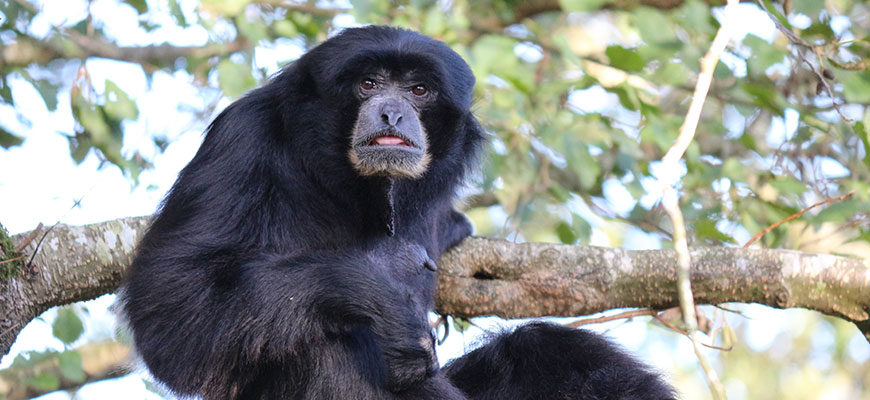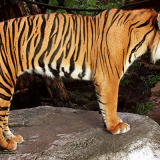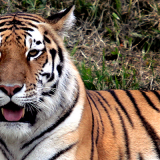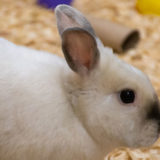RANGE
Rain forests of Sumatra and mainland Malaysia to altitudes of 5,900 feet.
HABITAT
Arboreal. Found living 80 – 100 ft. up in tall trees of the rainforest.
SIZE
Males and females are 3 feet tall and weigh 22 – 30 pounds, twice the weight of other gibbons.
REPRODUCTION
The look-alike sexes are distinguished by their calls; males scream or boom, females have a loud series of booms and barks. Their song is unique to the pair. Both sexes have a gray-pink throat sac that inflates to amplify the sound which can be heard 2 miles away. At daybreak and dusk the forest resounds with siamang calls. Calling in unison develops and maintains the pair bond and excludes neighboring groups from the family’s territory. Siamangs mate for life.
Births of a single 1.5 pounds baby occur every 2 – 3 years after a 230–235 day gestation. Early in its second year the baby is transferred from the mother to the father for most of its care. At age 5 or 6 the subadult’s desire to mate and resulting aggression from the same sex parent forces the subadult out of the family group. Subadults wander alone, sometimes for years, seeking a territory and a mate of their own. Bachelors often sing alone to attract a female. Sexual maturity is reached by 8 or 9.
DIET
Wild: 44% of the diet is ripe fruit and flowers, 48% is tender buds and leaves, and 8% is insects.
Zoo: Apples, pears, strawberries, melon, papaya, mango, figs, bananas, oranges, broccoli, green beans, cooked carrots, and sweet potatoes, celery, kale, romaine lettuce, monkey biscuits, crickets, mealworms; with raisins and grapes for treats.
BEHAVIOR
- Siamangs are diurnal, arboreal, and highly territorial. A mated pair with up to two offspring occupy and defend a 75 acre territory in order to ensure a food supply for the family. During the day the female leads her family around the territory interspersing brief periods of travel with long bouts of feeding on fruiting trees. Family members stay close, within 26 feet of each other. If they meet a group on the territorial boundary, the female and young hide while the adult and subadult males sit and stare at their neighbors, call loudly, break branches, run to and fro, and chase intruders across the boundary. Rarely is there physical contact between the males.
- At mid-morning the group ascends an emergent tree to rest and groom in pairs or all together in a huddle. This mutual grooming strengthens family ties.
- At midday, to escape the heat, siamangs rest and groom in the lowest levels of the canopy. They then continue to travel and feed, covering about 0.6 miles in a day. They travel further during the dry season when food is scarcer and move less in the wet season when it is more abundant.
- In the late afternoon, or even earlier if they have eaten their fill or if heavy rains start, groups head for the center of their territory. Here they settle for the night in regularly used sleeping trees. With callouses to cushion their rumps, Siamangs sleep sitting on narrow end branches where they are safe from attack by nocturnal predators such as clouded leopards.
POINTS OF INTEREST
- Siamangs are small black apes. They are tailless with arms twice as long as a human’s in proportion to body length. They hang by one long arm and use the other to gather fruit near the ends of branches. Their opposable thumb gives them a precision grip for selecting the ripest fruit and most tender leaves. Adults are equipped with formidable canines for piercing the fruit’s outer shell and for defense. Siamangs are too quick for most predators although a few are taken by pythons.
- Siamangs climb by grasping with their hands and feet and leap as far as 45 feet from one tree branch to another. But, they mainly move by “brachiation”, swinging arm over arm through the treetops, spanning twenty foot gaps in the canopy with powerful arm pulls. With the highly mobile thumb set far back on the wrist and turned across the palm during brachiation, siamangs use their long fingers to hook rather than grasp the branches.
- When traveling on a large tree limb or on the ground, siamangs walk upright with the arms held overhead for balance. They have broad feet and long opposable big toe. Siamangs do not swim. They avoid open water and rather than put their face in the water to drink, siamangs dip a hand in the water and suck off the moisture.
- Siamangs share the forest canopy with gibbons, langurs, macaques and the Sumatran orangutan. Where they meet at a food source the siamangs will often chase the others away, even the much larger orangutan.
- Hylobates means “dweller in the trees” and syndactylus means “having two or more digits webbed”.
STATUS
Important as seed dispersers and thus essential to rainforest diversity, siamangs are declining in number. Deforestation in Malaysia is resulting in an annual loss of 3,400 siamangs. They are listed as endangered by the USDI and have been placed on the CITES Appendix I. They are surviving in isolated forest relicts, but less than 4% of gibbon habitat is currently protected.
REFERENCES
All About Monkeys, by Robert S. Lemmon, Random House, New York 1958, pp. 92–96
Animals of Asia – The Ecology of the Oriental Region, by J. & K. Mackinnon, Holt, Rinehart & Winston, N.Y., Chicago, S.F. 1974, p. 25, 38, 40–41
Behavior of Nonhuman Primates, Vol. II Schier, Harlow & Stollnitz, Academic Press, N.Y., S.F., London, 1965, pp. 533, 540, 552
Introduction to the Primates Living & Fossil, S.I. Rosen, Prentice-Hall, New Jersey, 1974, pp. 110–117
Monkeys and Apes, by Prue Napier, Grosset & Dunlap, 1972, p. 11, 51, 53, 142, 144
Primate Conservation; Editors: Prince Rainier & G. Bourne Academic Press, N.Y., S. F., London, 1977 pp. 539–593
Primate Odyssey, G. Bourne, Putnam’s Sons. N.Y. 1974 pp. 257–265
Walker’s Mammals of the World, Fifth Edition, Vol. 1 by Ronald M. Nowak
Johns Hopkins University Press, Baltimore, London 1991, pp. 493–498
Zootails of the Fort Wayne Zoological Society – Song of the Siamang, by Vicki Ferrenplete Guide to Monkeys, Apes & other Primates, M. Kavanagh, Viking Press, 1984 pp. 179–183, 1995







